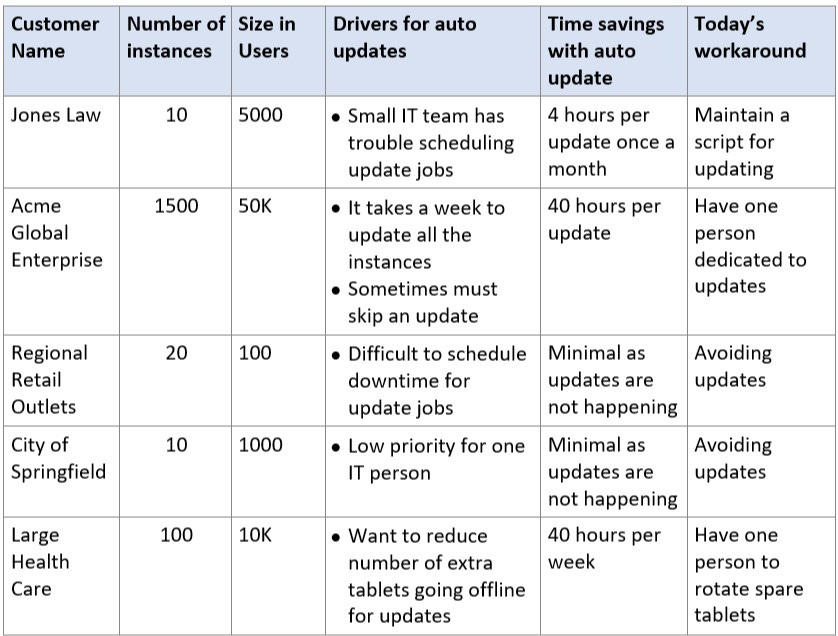5 Steps to Meaningful Customer Conversations
Product leaders crave customer feedback to provide the best product experience to their customers. How do you squeeze in meaningful customer conversations into your busy work week?
Setting Up Customer Conversations
Driving to meaningful customer conversations takes a bit of thought and preparation. For example, a few customers have asked about a major product change such as automatic software updates. How can you get meaningful information about this request from your customers?
Start with a list of compelling questions for discussion. Customers that want to influence your product direction will respond well to open ended questions. Seeing that you are giving serious consideration to their requests demonstrates that you plan to take action to provide product improvements that save their time.
For a major change such as automatic updates, some examples of compelling questions would be:
What prompted this request in your organization?
In what ways will automatic software updates save time in your organization?
Can you walk through an example of how you do updates with the current product?
Next, prepare a list of customers to contact about these questions.
Requesting a Customer Feedback Discussion
Invite a few customers to discuss your questions: You might deal with an account team, a partner or other trusted advisor before getting through to the end customer who could discuss your questions. On the above example about automatic updates, you would use a short email to request a meeting on your questions:
Make your request: discuss how the customer would use automatic updates
Let the customer know how you plan to use their answers: your team is investing in automatic updates and needs customer input before design is locked at end of quarter
Provide your question list
Schedule each customer session. Prior to each session, review the customer’s use of your product so you can spend more time on your questions.
Summary of Each Customer Conversation
Record the customer conversation and write summary notes afterwards: The notes from the customer conversations are helpful in many follow-on activities:
Writing requirements
Prioritizing ideas for further investigation
Estimating business cases
Updating product strategy
Competitive analysis
Customer references
User experience and workflow improvements
Key items to include in your notes are:
Name and title of the people in the customer conversation
Background about how the customer is using your product, for example:
scale of use such as number of users, size of storage, number of licenses
frequency of use such as daily, weekly
customer segment such as small business, retail, or enterprise
Screenshots of issues discussed in the walk through
Answers to your questions
Side issues raised
Save the notes in a shared folder so other product team members can make use of the customer conversation notes. However, don't blast your notes out to the product team! Prepare your summary first.
Analyzing the Customer Conversations
After completing 3-5 customer discussions, the next step is consolidating your notes into a table to communicate a summary. Below is the table from the example customer conversation about automatic updates. This table shows the key points from 5 customer conversations.
By consolidating the customer conversations, you notice these drivers for automatic updates:
customers are not keeping your software current
customers are putting in extra effort to handle updates
larger customers have developed scripts to save time
With these drivers in hand, the next step is to characterize the customers’ problems that could potentially be solved with automatic updates.
Characterize the Customer Conversations
After the customer conversations, your first thought might be to email the summary table and the recorded conversations to your engineering leads. This is a bad idea because you haven’t added your product manager thoughts. It would be much more useful to the engineering leads to get a story about the struggles your customers are having in manually updating your product.
Since you recorded your customers walking through their updates of your software, your next step is building a story to summarize what your customers are doing to keep your product up to date. A thoughtful summary of the customer conversations is much more valuable to your limited engineering team. How do you build a story about the customer conversations and get the attention from your engineering team?
Your Customer Conversation Story
A good story has the following parts:
a setting about the current situation
description of a problem or conflict
a resolution to the problem
The way to turn your customer conversations into a story is to pull out the moments that matter from your customer conversations to tell the consolidated customer story. A potential outline of the story of the automatic updates example is:
The current situation:
Interviewed a subset of customers about how they update their software
Found the following issues:
Delaying updates
Extra effort to make the updates
A few customers have scripts to help in updates
Customers do see value in keeping software current and looking for better ways to keep software updated
Describing the conflict:
Introduction of the typical person updating your software
Walk through what they do with screenshots
Preparation for the updates
Doing the updates
List of scripts and other aids the customers have developed
Point out a few key issues from the customer’s perspective
Discuss possible resolutions
Summary of the story
Request engineering to explore possible solutions with you
List of next steps such as next meeting, customer analysis, estimation of effort
The focus of the story is your customer’s pain points. The focus is *not* on agreeing to do automatic updates. In fact, the above outline doesn’t mention automatic updates. This is your opportunity to present the customer’s perspective and enable engineering to consider ways to help the customer.
Presenting the Story
Prepare to present the story about how customers update your software to small groups so your team can ask a lot of questions. The outcome you want is a lot of questions and discussion about possible solutions.
The result of presenting the customer conversations usually goes one of these ways:
Engineering team believes the problem is not bad enough to make a change
Engineering team has a great idea to address the problem quickly
Only way to fix the problem is big effort
Any of these responses is good. Why? Because you and the team decided how to respond to a customer issue.
Closure on Customer Conversations
With a decision about handling this batch of customer conversations, you need to finalize documentation from the customer meetings. The summary and the detailed meeting notes go into your prioritized list of improvements.
Additionally, you need to update your customers about the outcome of the customer conversation. For example, if it is going to take awhile before anything can be done about automatic updates then you can thank the customers for the conversation and let them know that their feedback was reviewed with the team. If there is something valuable to the customers coming soon, then you can let customers know that an improvement is planned.
Conclusion
The next time you need to talk to your customers about an issue, you have a new way to do it in a few steps:
Prepare to speak to your customers
Compel customers to discuss an issue
Summarize the customer conversation
Present the customers’ perspective to your team
Close on the customer conversation
Breaking down customer conversations into discrete activities enables you to tackle a major issue with minimal impact to your busy schedule. Each step in the customer conversation has small product management thought exercises. These activities can be done with small amounts of time spread over a few weeks.



